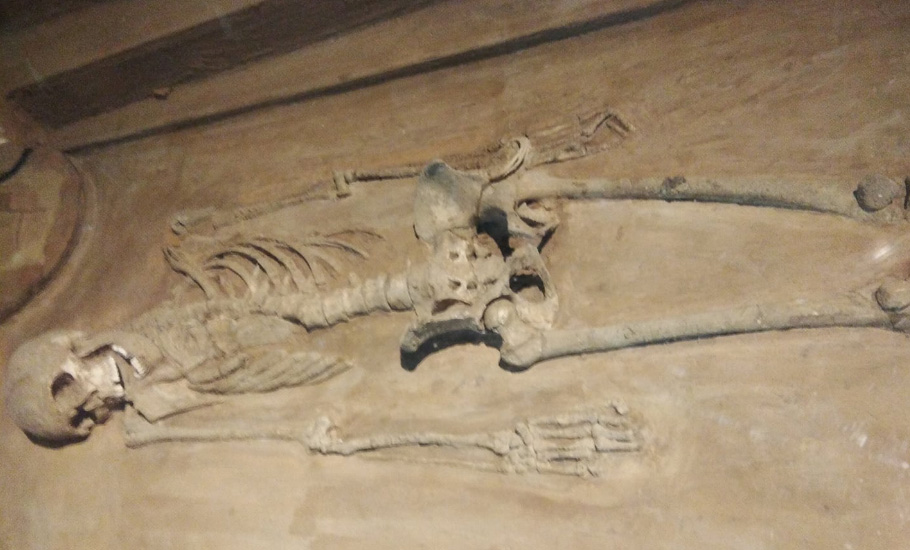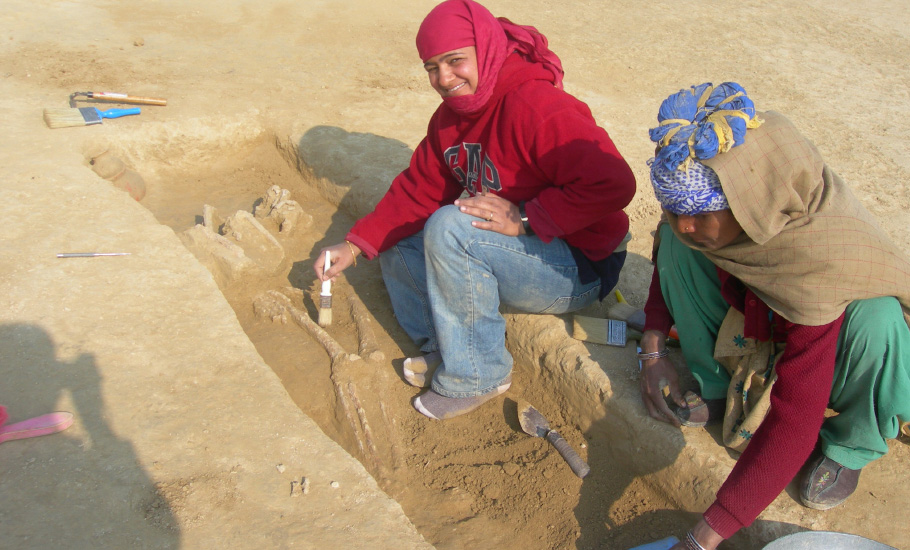
- Home
- News
- Analysis
- States
- Perspective
- Videos
- Education
- Entertainment
- Elections
- World Cup 2023
- Features
- Health
- Business
- Series
- Economy Series
- Earth Day
- Kashmir’s Frozen Turbulence
- India@75
- The legend of Ramjanmabhoomi
- Liberalisation@30
- How to tame a dragon
- Celebrating biodiversity
- Farm Matters
- 50 days of solitude
- Bringing Migrants Home
- Budget 2020
- Jharkhand Votes
- The Federal Investigates
- The Federal Impact
- Vanishing Sand
- Gandhi @ 150
- Andhra Today
- Field report
- Operation Gulmarg
- Pandemic @1 Mn in India
- The Federal Year-End
- The Zero Year
- Premium
- Science
- Brand studio
- Home
- NewsNews
- Analysis
- StatesStates
- PerspectivePerspective
- VideosVideos
- Entertainment
- ElectionsElections
- Sports
- Loading...
Sports - Features
- BusinessBusiness
- Premium
- Loading...
Premium

What the skeletons in the closet have to say about the dead

The dead don’t speak but their remains maybe screaming out the story of what happened to the dead. What it takes to listen to a person or animal for whom all that remains is a skeleton is an expert — an expert who can listen to skeletons. Skeletons of human beings and animals, excavated from archaeological sites, have been part of Veena Mushrif-Tripathy’s life since she started...
The dead don’t speak but their remains maybe screaming out the story of what happened to the dead. What it takes to listen to a person or animal for whom all that remains is a skeleton is an expert — an expert who can listen to skeletons.
Skeletons of human beings and animals, excavated from archaeological sites, have been part of Veena Mushrif-Tripathy’s life since she started researching palaeopathology, the study of ancient diseases from skeletal remains excavated from archaeological sites, two decades ago. A developing field in Indian archaeology, palaeopathology aims to trace the origin, evolution and history of diseases over long periods of time through pathological changes which represent diseases suffered in life and observed in human remains buried at archaeological sites.
A slight mark on a skeleton can mean a lot. For example, the skeletal markers of occupational stress can throw light on daily activity patterns of the individual, and on the broader scale, of the population. Reanalysis of skeletal collections has yielded new evidence of pathologies. Recent developments in methodology and technology like ancient DNA, DNA of pathogens, microscopy, isotope analysis and advancement in radiographic techniques have widened the scope of palaeopathology in India.
Being part of many archaeological excavations in India, Veena has studied in detail the skeletons to get an idea about the ancient people and society. She has documented many diseases such as leprosy, sinusitis and congenital anomalies so far. “Studies on the Balathal (Rajasthan) specimen indicate that lepromatous leprosy was present in India by 2000 BC. This is the oldest documented skeletal evidence for the disease from India,” said Veena Mushrif-Tripathy, assistant professor in physical anthropology at Department of Archaeology, Deccan College Post-Graduate and Research Institute, Pune.
However, the presence of leprosy in skeletal material dated to the post-urban phase of the Indus Age suggests that Mycobacterium leprae (the bacterium that causes leprosy) evolved in Africa. “Later, the disease migrated to India before the Late Holocene, possibly during the third millennium BC at a time when there was substantial interaction among the Indus Civilization, Mesopotamia, and Egypt,” she added.
Palaeopathology is the study of the evolution and progress of diseases through long periods of time. Combining biological and cultural data, it aims to examine how humans adapted to change in their environment. Veena shares her experience while studying various diseases such as metabolic and joint diseases, traumatic lesions, infectious and congenital diseases, stress factors, newborn formations, dental issues from the skeletal remains of humans and animals.

She also collaborated on skeletal data that she collected with literary sources. Veena said the origin of the Atharva samhita (1200-1000 BC) dates from the period when Brahmanism had become dominant and provides reference to leprosy and supports the suggestion that this ancient text is the earliest historical reference to the disease, its pathogenesis and treatment. At the same time, ‘Kushtha’ is the Sanskrit word referring to a plant used to treat leprosy and tuberculosis (Rajayakshma) in Atharva Veda.
Veena said teeth, being the most highly mineralised body structures, are unique and indeed sometimes the safe surviving human remains relating to past individuals and the societies to which they belonged. The well-preserved lesions produced by diseases of teeth and their supporting structures, according to her, can tell us much about health and diet, which is usually strongly related to economic and social status. Some of the dental diseases found in antiquity are enamel hypoplasia, periodontal disease, ante mortem tooth loss, failure to erupt, calculus, osteitis and periostitis.
“Neoplasm or new growths are in essence the uncontrolled growth of tissue cells. There are two main types of bone growth. One is malignant and the other is benign. The benign type is clinically insignificant as they remain local and without a generalised bodily effect. It is possible to mistake non-neoplastic processes for actual tumours,” she said.
Trauma in palaeopathological literature is defined as any bodily injury. “The anatomical importance and sociocultural implications of trauma in antiquity have long been recognised and the description of trauma in human skeletal remains and the identification and comparison of trauma patterns among ancient populations therefore have a lengthy history,” said Veena. Similarly, infection is very commonly found in archaeological context.
“It is very difficult to distinguish between the various infectious disorders that can affect the skeleton and sometimes prove to be a challenging exercise. Skeletal manifestations of diseases include abnormal bone formation, abnormal bone destruction. There are two main types of infections. The first one is non-specific infections where it is very difficult to diagnose the cause. The second one is specific infection where the cause of infection is possible to diagnose. For example, leprosy and tuberculosis,” she added.
It is interesting to see the presence of maxillary sinusitis, an infection to the maxillary floor, in archaeological populations from protohistoric (1500 BC) and mediaeval India and to understand it from a socio-economic perspective, according to Veena. “There were 269 individuals studied from six sites, but only 74 individuals (79 maxillae) were available for inspection. The observations also show that nine out of 79 maxillae (11.39 per cent) are affected. The study shows that a dental origin of the pathology is more common in males than in females. Various reasons have been encountered as the cause behind sinusitis and both males and females have infections,” she said, quoting her earlier study.
“Exposure to polluted air from domestic activities such as cooking and contact to dust or smoke and other particles present in the surrounding environment and certain vocations could be a vital cause of respiratory tract infections, including maxillary sinusitis,” Veena told The Federal.
Congenital anomalies are the physical condition deviating from what is acceptable as normal that began before birth can be called a congenital anomaly. Veena said recent molecular studies in embryology have shown that most of these anomalies are genetically determined. “Most major defects have disastrous effects on the developing foetus and frequently end with spontaneous abortion or cause death soon after birth. Therefore finding the more serious congenital anomalies in ancient human remains is rare,” she said. There are limitations for diagnosing skeletal anomalies because the study is restricted to those diseases that affect the skeleton, according to Veena.
“Determining the cause of death is often a speculation. The population studied are dead and may not be representative of a living group. The bone produced showed limited ways of reacting to diseases,” she said.
Investigations by Veena’s team have not only contributed substantial new data on reconstructing the genetic history of the Parsi population, but has also provided a more comprehensive insight into the population structure of the Parsi communities and their genetic links to Iranian and South Asians. “The Parsis are genetically closer to Iranian and South Asians. We show that the Parsis are genetically closer to Iranian and Caucasian populations than those in South Asia and provide evidence of sex-specific admixture with the prevailing female gene flow from South Asians to the Parsis. Our results are consistent with the historically recorded migration of the Parsi population to South Asia in the 7th century and in agreement with their assimilation into the Indian subcontinent’s cultural milieu ‘like sugar in milk,’” she said.
In Roopkund lake, a high altitude glacial water body in Uttarakhand, Veena and her team found the genome-wide ancient DNA for 38 skeletons and they clustered into three distinct groups. A group of 23 individuals have ancestry that falls within the range of variation of present-day South Asians. A further 14, according to Veena, have ancestry typical of the eastern mediterranean. The team also identified one individual with Southeast Asian-related ancestry. “Radiocarbon dating indicates that these remains were not deposited simultaneously,” said Veena.
The problem of the Aryan invasion has been a very sensitive issue for Indians from a historical, archaeological and anthropological point of view. It was interpreted that Aryans were responsible for the decline of the Harappan Civilisation (3500 to 1500 BCE). The hypothesis was based on the scattered skeletal remains excavated at the site of Mohenjo-daro. The so-called invasion also is in question from a palaeopathological point of view.
“If we consider the evidence from disarticulated skeletal remains from Mohenjo-daro, one should be able to get some traumatic marks on bones. Death by an axe or sword may not be registered on the bone if the wound is superficial and if only the soft parts are traumatised. But it is reasonable to expect actual wound-marks in case of unceremonious slaughter, which are not present in Mohenjo-daro specimens,” she said.
The proposition of a traumatic end of Harappan culture (Mohenjo-daro in particular) is based on essentially archaeological evidence of disorderly disposal of dead rather than on the skeletal evidence of trauma. In this case the problem of interpreting the disarray of skeletons becomes more complicated, according to Veena. This haphazard mode of disposal of dead might have had some social implications rather than being solely pathological. She said anthropology or archaeology has no conclusive answer to this puzzle at present.
“It may be mentioned that some scholars believe that the Mohenjo-daro individuals exhibit a unique pattern of regional phenotypic variability with striking differences setting them apart from skeletal series at other Harappan sites. It has been claimed that the skeletons in question may belong to a post-Harappan period and share no direct biological affinity with the population of the mature Harappan phase. Therefore, the Aryan invasion is not a fact but a fallacy,” said Veena.

